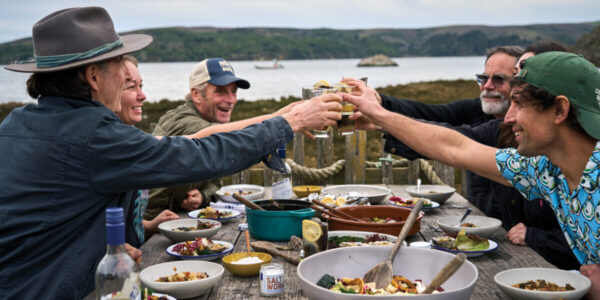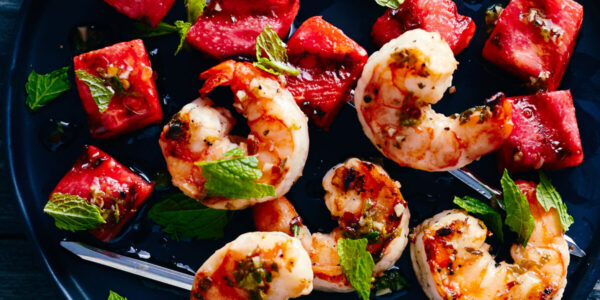Grilled Butterflied Turkey with Fennel Garlic Rub

Photo: Romulo Yanes; Styling: Claire Spollen
After years of experimenting with different techniques in the Test Kitchen, we’ve landed on butterflying and grilling as the path to a better bird. Flattened out, the turkey cooks more evenly and quickly, keeping the meat moist, while grilling produces ultra-crisp skin. Plus, your oven is freed up for cooking sides.
Equipment Notes: For brining, you’ll need a 12-qt. or larger stockpot (or a smaller pot and a brining bag). You’ll also need a 12- by 18-in. foil roasting pan. Lastly, consider getting an inexpensive cable-style thermometer (such as Polder); it will let you track the bird’s temperature without uncovering the grill and losing heat. For another variation on the rub, try Grilled Butterflied Turkey with Celery Herb Rub.
This recipe, and others like it, can be found in the article “From Classic to Unexpected, These Thanksgiving Turkey Recipes Are Total Winners.”
How to Make It
Make a brine (it's a win over a dry salt rub because it penetrates all parts of the turkey more evenly). Heat salt and peppercorns with 1 1/2 qts. water in a 12-qt. stockpot over high heat, stirring, until dissolved. Remove brine from heat, stir in 3 qts. ice water, and let cool. Discard lumps of fat from butterflied turkey. Rinse turkey and set breast down in pot. If needed, add more cold water so turkey is just covered. Chill, covered, 12 to 16 hours.
One hour before cooking, set a cooling rack in a large rimmed baking sheet. Drain and rinse turkey, then set on rack to continue draining about 30 minutes.
In a small bowl, combine fennel seeds, chopped rosemary and thyme, ground fennel, chopped sage, garlic powder, and pepper.
Remove rack from under turkey and drain liquid from baking sheet. Pat turkey dry and smear all over with oil. Season with fennel mixture. With breast up, tuck wings under body (helpful for keeping the turkey fairly flat as it grills). Wrap ends of drumsticks with a quadruple thickness of foil.
Meanwhile, prepare grill for indirect medium-high heat (400° to 450°). You'll cook the turkey over a cooler area, and over a pan of water, to cook the turkey very evenly--and so its dripping juices won't cause flare-ups. If using gas: Remove cooking grates. Turn all burners to high, close lid, and heat 10 minutes. Turn off center burner(s) and reduce heat for others to medium-high. Set a 12- by 18-in. foil roasting pan on turned-off burner and add 1 qt. hot tap water. Oil cooking grates and set in place (if drip pan sticks up, push down on grates to flatten pan a bit). If using charcoal: Ignite a full chimney of briquets (about 90) on firegrate. When coals are dotted with ash, in 20 minutes, bank evenly on opposite sides of firegrate and if needed, let burn to medium-high. (Be ready to add turkey as soon as fire is 450° to 475°.) Set a 12- by 18-in. foil roasting pan between coals and add 1 qt. hot tap water. Oil cooking grate and set in place.
Set turkey, breast side up with legs facing in, on cooking grate over drip pan. Insert a digital wand-style thermometer (such as Polder) through thickest part of breast to the bone (testing the temperature at the bone, where it's coolest, gives the most consistent reading). Position the readout near the grill. If using charcoal: Beginning 15 minutes into cooking, add 5 briquets to each mound of coals every 30 minutes. Also occasionally clear ash with metal sweeper beneath grill. If temp drops to 375°, increase briquets to 8 to 10 on each side and leave grill uncovered a minute or two to ignite.
Grill turkey, covered, until thermometer registers 160°*, 1 1/2 to 2 hours. With two wide spatulas, transfer turkey to a cutting board. Tent loosely with foil and let rest in a warm place about 15 minutes.
Carve turkey, set on a platter, and tuck herb sprigs around meat.
*Not all kosher salts are created equal--flaky Jacobsen and Diamond Crystal salts are fluffier than Morton's. Ask a butcher to butterfly turkey, or see How to Butterfly a Turkey, below; save backbone, neck, tail, and giblets (except liver) for gravy. After grilling, turkey temperature will rise 5° to 8° as it rests.
How to Butterfly a Turkey
A butterflied turkey (meaning, one with the backbone removed and the turkey flattened like an open book) cooks evenly and quickly. For grilling, choose a 12- to 14-lb. turkey, which is small enough to fit within the indirect heat area and will serve 10 to 12 people.
Set turkey breast down in a clean sink (you have more leverage at this level rather than on a counter). Remove any plastic or metal turkey truss and discard. With poultry shears**, cut along both sides of backbone and remove it; save for gravy. Cut off tail and loose skin and save for gravy.
Turn turkey breast up. Using some muscle, press down hard on turkey with hands on top of each other to crack breastbones in several places and flatten breast so it's just a bit taller than legs.
**We like Wüsthof classic poultry shears, which are spring-loaded and easily cut through bones; $80; williams-sonoma.com.

